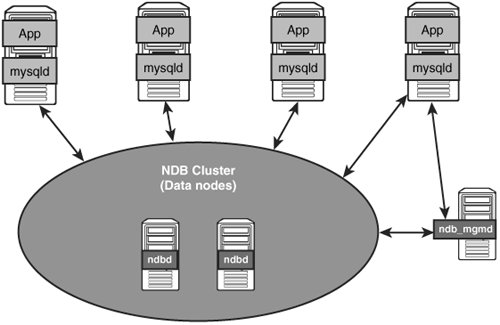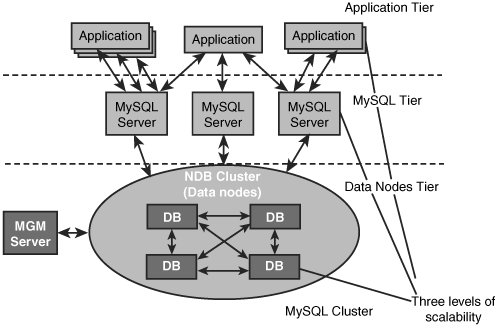Web Farm/MySQL Farm
Web Farm MySQL Farm
As your application grows, or if you are architecting a large-scale application to begin with, you should consider some alternate architectures for your application. The following sections describe two possible setups for a more complex web application.
One-to-One Relationships
In a one-to-one relationship setup, as shown in Figure 7.2, there is a direct mapping between the MySQL server and your application server. Each instance of your application server has a single running instance of MySQL that it connects to. Normally, this is on the same physical server, using local connections between the two servers. Under this level, you can have any number of data nodes. For example, if you have four Apache servers, you would have four MySQL servers, with each of them running on the same physical server as the Apache server does, and then two data nodes running on different hardware below them. This allows for automatic load balancing because you only have to load balance in front of the application server, which is normally a relatively easy task. Also, this handles hardware failures properly because when the hardware fails, you lose both the application server and the MySQL server, which prevents any waste of resources.
Figure 7.2. A one-to-one relationship.

The problem with using this method is that it doesn't work for all types of applications. It only works where you have a limited number of programs that will connect to MySQL. This works well in situations such as web applications, but it doesn't work for client/server model types of applications. In addition, it prevents you from scaling different portions of your architecture at different paces because you need to maintain the one-to-one relationship.
Creating a Separate Web Farm and MySQL Farm
In the separate farm setup, you keep the application servers separate from the entire cluster setup. This allows you to scale the different pieces of your application/database setup as needed. If you run into a bottleneck in the application, you can scale by adding more application servers, and the same could apply for MySQL servers or data nodes. As shown in Figure 7.3, these three levels of scaling can allow you to scale to even the largest workloads that applications can see.
Figure 7.3. Scalability of multi-tier farms.

Client/Server Applications
The client/server setup is very similar to the Web farm/MySQL farm discussed in the preceding section. The only difference is that this setup has many clients instead of a small set of application servers as the few connecting clients. An example of this would be an application that runs on a desktop client and logs directly in to MySQL across the network for reporting purposes. In this case, you will need to generally scale the MySQL servers in a much faster way, based on the number of client applications.
Installation
- Installation
- Before You Begin with MySQL Cluster
- Installing MySQL-Max
- Retrieving the Latest Snapshot from BitKeeper
- Ensuring That MySQL Cluster Works
- Auto-discovery of Databases
- Startup Phases
- Restarting a Cluster
- Testing Your Cluster
- Upgrading MySQL Cluster
- Obtaining, Installing, and Configuring MySQL Cluster on Other Platforms
- RAM Usage
- Adding Tables
- Common Errors While Importing Tables
Configuration
- Configuration
- The Structure of config.ini
- Management Nodes
- Storage Nodes
- SQL Nodes
- Using Multiple Management Nodes
Backup and Recovery
Security and Management
- Security and Management
- Security for MySQL Cluster
- Managing MySQL Cluster
- Running MySQL in a Chrooted Environment
Performance
- Performance
- Performance Metrics
- MySQL Cluster Performance
- Benchmarking
- Indexes
- Query Execution
- Data Retrieval in MySQL Cluster
- Physical Factors
- High-Speed Interconnects
Troubleshooting
Common Setups
A MySQL Cluster Binaries
B Management Commands
- B Management Commands
- Displaying the Status of the Cluster/Controlling Nodes
- Logging Commands
- Miscellaneous Commands
C Glossary of Cluster Terminology
Index
EAN: 2147483647
Pages: 93
